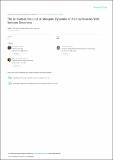| dc.contributor.author | Seleman A., Mohamedi | |
| dc.contributor.author | Luboobi S., Livingstone | |
| dc.contributor.author | Nkansah-Gyekye, Yaw | |
| dc.date.accessioned | 2019-05-15T09:12:05Z | |
| dc.date.available | 2019-05-15T09:12:05Z | |
| dc.date.issued | 2017-08-25 | |
| dc.identifier.uri | Mathematical Sciences · August 2017 DOI: 10.20852/ntmsci.2017.196 | |
| dc.identifier.uri | http://dspace.nm-aist.ac.tz/handle/123456789/66 | |
| dc.description | Research Article published by New Trends in Mathematical Sciences | en_US |
| dc.description.abstract | In this study, a mathematical model for the in-human host and in-mosquito dynamics of malaria parasite with immune
responses was formualeted and analyzed. A positive invariant region of the model was established, and a basic reproduction number
R0, of the model was computed. Existence and stability of two non-negative equilibrium points: malaria free equilibrium (MFE) and
malaria infection equlibrium (MIE) were established. We, also proved that MFE is locally asymptotically stable if R0 < 1 and globally
asymptotically stable (GAS) if R0 ≤ 1. Numerical simulations prove that MIE exists and is GAS. Moreover, our results revealed that
immunity has significant influence on lowering malaria infection at blood and mosquito stages. However, an insignificant effect of
immunity on both cells and parasites at liver stage infection was observed. Furthermore, the model depicts that infection decreases as
lifespan of immune cells increases. The impact of immune cells to suppress production of merozoites is noted to be higher than that of
antibodies to block invasion of sporozoites and merozoites. | en_US |
| dc.language.iso | en_US | en_US |
| dc.publisher | New Trends in Mathematical Sciences | en_US |
| dc.subject | Malaria parasites | en_US |
| dc.subject | in-human host and in-mosquito dynamics | en_US |
| dc.subject | immune responses. | en_US |
| dc.title | The in-Human Host and in-Mosquito Dynamics of Malaria Parasites With Immune Responses | en_US |
| dc.type | Article | en_US |

